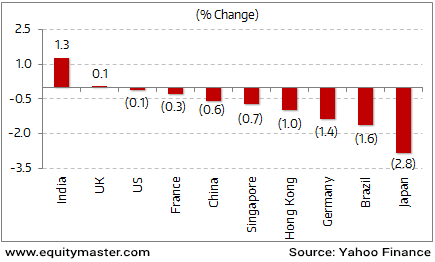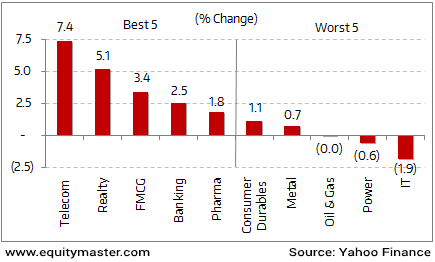Global markets ended the week on a weak note with most markets ending in the negative territory. The Indian market was the biggest gainer, with gains of 1.3%. On the other hand, Japan and Brazil markets were down by 2.8% and 1.6% respectively.
US Markets have run up sharply following Trump’s November 8 election win on the expectation that tax cuts, deregulation and a fiscal stimulus would accelerate economic growth. Lately, however, US stocks and the dollar have cooled off as uncertainty grows about Trump’s ability to push through the market-positive aspects of his plans, and on worries about some of the more aggressively ‘America First’ policies, particularly on immigration.
Earlier in the week, the US Federal Reserve held interest rate unchanged in its first meeting since President Donald Trump took office, but painted a relatively upbeat picture of the US economy that suggested it was on track to tighten monetary policy this year. The Federal Open Market Committee (FOMC) – the US central bank’s policy making arm – kept its benchmark overnight lending rate target at a range of 0.5% to 0.75%. In December, the Fed raised the target a quarter point, or 25 basis points, marking just the second hike in more than 10 years. The US central bank said job gains remained solid, inflation had increased and economic confidence was rising, although it gave no firm signal on the timing of its next rate move. The DJI Index was marginally down by 0.1% for the week gone by.
Meanwhile, The People’s Bank of China unexpectedly raised the interest rates on open market operations, adding to growing concerns about US President Donald Trump’s aggressive policies. On the first day of trading after a week-long break for the Lunar New Year, the currency also weakened after the People’s Bank of China raised the interest rates on open market operations by 10 basis points. The Shanghai Composite Index was down marginally by 0.6% for the week gone by.
Eurozone witnessed a rise in inflation during the month of January. Data released during the week showed inflation accelerated to 1.8% YoY in January. This was against 1.1% in December and just below the European Central Bank’s (ECB) target of 2%. It was the highest rate since February 2013 and showed prices rising in Germany, France, and Spain – three of the bloc’s four biggest economies. On the other hand, core inflation was stable at 0.9% YoY. The core inflation excludes volatile prices of energy and unprocessed food. Apart from the above, gross domestic product in the Eurozone rose 0.5% QoQ in the last three months of 2016. Stock markets in Germany and France were down by 1.4% and 0.3% for the week gone by.
Back home, a smart rally on the budget day pushed the market to end the week higher, however, the cautious sentiment ahead of the Reserve Bank of India’s policy meeting and visa woes on the IT sector kept the momentum slow in the last two trading sessions. The BSE Sensex was up 1.3% for the week, while the NSE Nifty gained 1.2%. Mid cap and Small cap stocks outperformed. The BSE Mid cap index rose 2.5%, while the BSE Small cap index surged 2.4%. In the coming week, Index of Industrial Production (IIP) data on Tuesday and Reserve Bank of India’s policy meeting scheduled for Wednesday will be under investors’ radar.
Key World Markets During the Week

On the sector indices front, telecom and realty stocks led the gainers this week. On the other hand, stocks from IT and power witnessed selling pressure.
BSE Indices During the Week

Now let us discuss some key economic and industry developments during the week gone by
The Finance Minister tabled the Union Budget 2017-18 on February 1st. The Union Budget focused on 10 distinct themes: Farmers, rural population, energizing youth, poor and underprivileged, infrastructure, financial sector, digital economy, public service, prudent fiscal management, and tax administration. The total budget expenditure of the budget this year is pegged at Rs 21,470 Billion. Despite the high figure the government has managed to keep the budgeted expenditure at a fiscal deficit of 3.2% as against the FRMB recommendation of 3% for the current fiscal.
The Finance Minister announced a slew of sops and tax benefits among other fiscal announcements. Presently the burden of taxation was mainly on salaried class. Post demonetisation, there was a legitimate expectation of reduced burden. In accordance to this expectation, in news that will bring cheer to the majority of the tax paying population., the Income tax has been halved to 5% for those earning between Rs. 250,000 and Rs. 500,000. The Finance Minister said that this move is to reduce the burden on tax payers and bring in more people under the tax net, through lower rates.









Leave A Comment